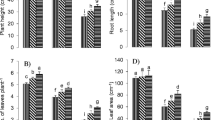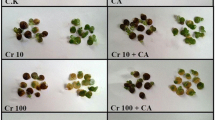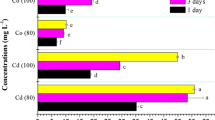Abstract
Phytoremediation is a green technology for the remediation of contaminated ecosystems by using plants. In the present study, a hydroponic experiment was conducted to investigate the phytoremediation potential of eight canola (Brassica napus L.) cultivars for hexavalent chromium [Cr(VI)]. Chromium significantly affected dry weight, lipid peroxidation, chlorophylls, non-protein thiol and antioxidant enzymes. Based on the dry weight, the tolerance index was found maximum in cultivar (cv.) NK Petrol and minimum in cv. Sary. The cv. Sary accumulated the maximum amount of Cr (705.8 μg g−1 DW), which was correlated with the lowest levels of chlorophyll content and highest levels of lipid peroxidation. However, Cr accumulation was lowest (255.0 μg g−1 DW) in NK Petrol. Although cv. NK Petrol may be a Cr(VI) excluder relative to cv. Sary, it may have the potential for the phytoremediation of Cr-contaminated sites as it possesses higher resistance to Cr(VI) by producing higher biomasses.
Similar content being viewed by others
References
Aebi H (1984) Catalase in vitro. Method Enzymol 105:121–126
Beauchamp C, Fridovich I (1971) Superoxide dismutase: improved assays and an assay applicable to acrylamide gels. Anal Biochem 44:276–287
Blaylock MJ, Salt DE, Dushenkov S, Zakharova O, Gussman C, Kapulnik Y, Ensley BD, Raskin I (1997) Enhanced accumulation of Pb in Indian mustard by soil-applied chelating agents. Environ Sci Technol 31:860–865
Bradford MN (1976) A rapid and sensitive method for the quantitation of microgram quantities of protein utilizing the principle of protein–dye binding. Anal Biochem 72:248–254
Chance B, Maehly AC (1955) Assay of catalase and peroxidase. In: Colowick SP, Kaplan NO (eds) Methods in enzymology, 2nd edn. Academic Press, New York, pp 764–775
Chaney RL, Angle JS, Broadhurst CL, Peters CA, Tappero RV, Sparks DL (2007) Improved understanding of hyperaccumulation yields commercial phytoextraction and phytomining technologies. J Environ Qual 36:1429–1443
Cobbett C, Goldsbrough P (2002) Phytochelatin and metallothioneins: roles in heavy metal detoxification and homeostasis. Ann Rev Plant Biol 53:159–182
Diwan H, Ahmad A, Iqbal M (2008) Genotypic variation in the phytoremediation potential of Indian mustard for chromium. Environ Manage 41:734–741
Heath RL, Packer L (1968) Photoperoxidation in isolated chloroplasts I. Kinetics and stoichiometry of fatty acid peroxidation. Arch Biochem Biophys 125:189–198
Hernández-Allica J, Becerril JM, Garbisu C (2008) Assessment of the phytoextraction potential of high biomass crop plants. Environ Pollut 152:32–40
MacRae EA, Fergusam IB (1985) Changes in catalase activity and H2O2 concentration in plants in response to low temp. Physiol Plant 65:51–56
Nagalakshmi N, Prasad MNV (2001) Responses of glutathione cycle enzymes and glutathione metabolism to copper stress in Scenedesmus bijugatus. Plant Sci 160:291–299
NMKL (1998) Metals: determination by atomic adsorption spectrophotometry after wet digestion in microwave oven. In: NMKL Method No. 161, Nordic Committee on Food Analysis, Norway, p 8
Pandey V, Dixit V, Shyam R (2005) Antioxidative responses in relation to growth of mustard (Brassica juncea cv. Pusa Jai Kisan) plants exposed to hexavelant chromium. Chemosphere 61:40–47
Pandey V, Dixit V, Shyam R (2009) Chromium effect on ROS generation and detoxification in pea (Pisum sativum) leaf chloroplasts. Protoplasma 236:85–95
Shanker AK, Cervantes C, Loza-Tavera H, Avudainayagam S (2005) Chromium toxicity in plants. Environ Int 31:739–753
Singh KP, Mohan D, Sinha S, Dalwani R (2004) Impact assessment of treated/untreated wastewater toxicants discharged by sewage treatment plants on health agricultural and environmental quality in the wastewater disposal area. Chemosphere 55:227–255
Tiwari KK, Singh NK, Rai UN (2013) Chromium phytotoxicity in radish (Raphanus sativus): effects on metabolism and nutrient uptake. Bull Environ Contam Toxicol 91:339–344
Vajpayee P, Tripathi RD, Rai UN, Ali MB, Singh SN (2000) Chromium(VI) accumulation reduces chlorophyll biosynthesis, nitrate reductase activity and protein content in Nymphaea alba L. Chemosphere 41:1075–1082
Wellburn AR (1994) The spectral determination of chlorophylls a and b, as well as total carotenoids, using various solvents with spectrophotometers of different resolution. J Plant Physiol 144:307–313
Yıldız M, Terzi H, Bingül N (2013) Protective role of hydrogen peroxide pretreatment on defense systems and BnMP1 gene expression in Cr(VI)-stressed canola seedlings. Ecotoxicology 22:1303–1312
Yu R, Ji J, Yuan X, Song Y, Wang C (2012) Accumulation and translocation of heavy metals in the canola (Brassica napus L.)—soil system in Yangtze River Delta China. Plant Soil 353:33–45
Zhang H, Lian C, Shen Z (2009) Proteomic identification of small, copper-responsive proteins in germinating embryos of Oryza sativa. Ann Bot 103:923–930
Zhang H, Tian Y, Wang L, Zhang L, Dai L (2013) Ecophysiological characteristics and biogas production of cadmium-contaminated crops. Bioresource Technol 146:628–636
Acknowledgments
This research was financially supported by the Afyon Kocatepe University Research Fund (Project No. 12.FEN.BIL.01). The authors also wish to thank Afyon Kocatepe University’s Foreign Language Support Unit for some language editing.
Author information
Authors and Affiliations
Corresponding author
Rights and permissions
About this article
Cite this article
Terzi, H., Yıldız, M. Variations in Chromium Tolerance and Accumulation among Canola (Brassica napus L.) Cultivars. Bull Environ Contam Toxicol 93, 113–119 (2014). https://doi.org/10.1007/s00128-014-1255-0
Received:
Accepted:
Published:
Issue Date:
DOI: https://doi.org/10.1007/s00128-014-1255-0




